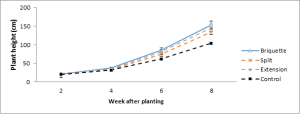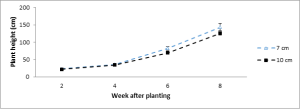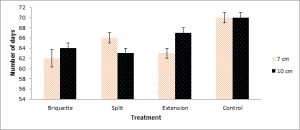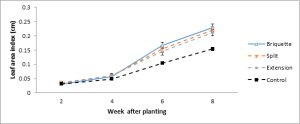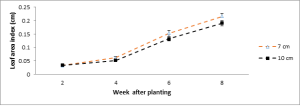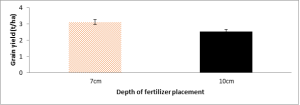Effect of Depth of Placement of Granular and Briquetted NPK on Growth and Yield of Maize (Zea mays)
- Amos Owusu
- Raphael Adu-Gyamfi
- 139-148
- May 30, 2024
- Earth Science
Effect of Depth of Placement of Granular and Briquetted NPK on Growth and Yield of Maize (Zea mays)
Amos Owusu, Raphael Adu-Gyamfi
Agronomy Department, Faculty of Agriculture, University for Development Studies (UDS), Nyankpala Campus, P. O. Box TL 1882, Tamale, GHANA
DOI: https://doi.org/10.51244/IJRSI.2024.1105007
Received: 10 April 2024; Accepted: 02 May 2024; Published: 30 May 2024
ABSTRACT
This experiment was conducted at the University for Development Studies, Nyankpala campus experimental field to determine the effect of depth of placement of granular and briquetted NPK on growth and yield of maize. The treatments consisted of two factors laid out in Split plot design and replicated three times. Fertilizer treatments served as main plot factor with the levels being NPK briquette, Granular split, Extension recommended and No fertilizer. Depth of fertilizer placement was taken as sub plot factor with two levels,7 cm and 10 cm. Maize variety used was Opeaburo, a hybrid variety. The application of two briquetted NPK per plant at the depth of 7cm recorded the highest plant height, grain yield, leaf area index, days to 50% silking and tasselling, higher agronomic and nitrogen use efficiency. Farmer applying briquette fertilizer at the depth of 7cm will have superior advantage in terms of yield and cost. Further experiment should be conducted in developing equipment for briquette application in maize. Also the experiment should be repeated on farmer’s field at different agro ecological zones to evaluate the performance of briquette at these locations.
Keywords: Depth of fertilizer placement; Maize grain yield; Agronomic and Nitrogen use efficiency; Briquette fertilizer; Granular fertilizer
INTRODUCTION
In Ghana maize is the largest staple crop and contributes significantly to consumer diets. It is the number one crop in terms of area planted (about 1,000,000 hectares) and accounts for 50-60% of total cereal production. Additionally, maize represents the second largest commodity crop in the country after cocoa. Maize is one of the most essential crops for Ghana’s agricultural sector and for food security (MiDA, 2010).
Maize is used for three main purposes; animal feed, food and in industry as raw materials for production of starch and brewing. It has become the most important raw material for animal feed and several industrial processes due to its low price and widespread distribution. Seventy percent (70%) of maize produced worldwide is used for livestock feed (Onimisiet al., 2009).
Maize production in Ghana is done by small holder farmers who constitute about 70% of maize farmers. The average yield of maize registered by the Ministry of Agriculture in 2013 was 1.7 Mt/ha compared to an estimated achievable yield of around 6 Mt/ha (MoFA, 2013).
World food security is confronted by many issues, including weather and climate variability, degraded soils and persistent poverty. In order to address these problems, the cost of agricultural inputs especially fertilizers must be brought down to improve stakeholder returns and promote agricultural intensification. Improving fertilizer use efficiency by reducing nutrient losses is a critical step towards increasing soil fertility and agricultural productivity for poor farmers (IFDC, 2015). Since no farm can be reasonably expected to raise great quantities of high quality crops without providing the necessary amounts of plant nutrients, fertilizer expenses are one of the greatest variable costs to any flourishing farm operation (Economic Research Service, 2013).
Among all the plant nutrients essential for agronomic crop production, N is one of the most important for non-leguminous crops because it is one of the most deficient nutrients in the soil relative to crop needs. It is a key component of all amino acids; it is also a major constituent in numerous important biochemical materials including nucleic acids, amides, amines, nucleotides, chlorophyll, and coenzymes (Taiz and Zeiger, 2002).Briquetting of fertilizers in the production of some crops have been adopted and found to be successful. Briquette fertilizers such as NPK, mixture of urea, triple super phosphate and muriate of potash, prilled urea and urea super granule (USG) have been used in many researches and have proven to be good over the application of the granular fertilizer in split application. Farmers in Vietnam and Cambodia obtained 25% higher yields with deep placement of NPK briquettes over the broadcasting of fertilizer (IFDC, 2007). Deep placement of fertilizers, especially urea, has resulted in better yields and lower N and P losses from flooded rice fields (Kapoor et al., 2008b; Bowen et al., 2005).
Maize production in Northern Ghana mainly relies on the use of inorganic fertilizers for supply of N, P, and K nutrients. Farmers always apply nutrients twice; thus using NPK fertilizer for basal application and applying either Sulphate of Ammonia or Urea as top dressing in order to gain higher yields. However, these nutrients are usually placed on the surface of the soil and are easily affected by volatilization, leaching losses and surface runoff. Also some farmers find it difficult to buy the fertilizer due to inadequate fund thereby leading to lower yields. Applying fertilizer twice is costly and also time consuming. These nutrients can be applied deep into the soil at once by processing them into a form of briquette (NPK briquette), by the use of briquetting machines in order to save time, cost and also increase yield.
In order to attain the expected yields, a comprehensive technology is required that can exhibit an efficient use of added nutrients. Deep placement can be done with simple tools and by the way aim in the reduction in labour requirement and cost of split application of fertilizers to farmers. Deep placement of fertilizers, especially urea, has led to improved yields and lower N and P losses from flooded rice fields (Kapoor et al. 2008a; Bowen et al., 2005). Farmers in Vietnam and Cambodia obtained 25% higher yields with deep placement of NPK briquettes over the broadcasting of fertilizer (IFDC, 2007). Deep placement of N fertilizer has the potential to increase N use efficiency in maize (Dotson et al., 2007). Therefore, there is a need to research into briquetted fertilizers and fertilizer deep placement and its effects on the growth and yield of maize.
MATERIALS AND METHODS
Experimental site
The experiment was conducted at the experimental field of University for Development Studies, Nyankpala in the Northern region of Ghana. The area experiences unimodal rainfall pattern with a mean annual rainfall of 900-1100 mm distributed fairly from the month of April to November (SARI, 2004). There has been a uniform temperature distribution with a mean monthly minimum temperature of 21.9ºC and a maximum of 34.1ºC and a minimum relative humidity of 53%, maximum of 80%. The area lies within the guinea savannah zone which is made up of predominantly native trees such as Shea (Vitelleriaparadoxa), Dawadawa (Parkiabiglobosa) and Neem (Azadirachtaindica), (SARI, 2005) which is interspersed with tall shrubs and grasses such as Heteropogonspp, Hypharrheniaspp and Andropogongayanus. The soils consist of yellow-brown clay and silt which develops principally from local colluviums and belongs to the Kpalsagwu series (SARI, 1993) or plinthic acrisols (FAO / UNESCO, 1988).
Experimental design and layout
The treatments were laid down in split plot design with 3 replications. Each subplot measured 4×4 m with 1 m in between subplots and 1.5 m between replications. Fertilizer treatment was taken as main plot factor and depth of fertilizer placement as sub plot factor.
Treatments
The treatments consisted of NPK briquette applied once at 2 briquette /plant. The amount of nutrient in the briquettes was supplied in granular form by using NPK (23-10-5) for basal application and Sulphate of Ammonia as top dressing. Extension recommended fertilizer rate was included as well as untreated control. The treatments were:
A. Main plot level (Fertilizer treatment)
T1: Briquette: (8 g briquette/plant) (102.4 Kg N/ha-44.5 KgP2O5/ha -22.3 kgK2O/ha), T2: Granular Split: Split application of T1 using granular NPK and SA [5.3 g/plt NPK; 2.7 g/plt SA., T3: Extension: Extension Recommendation- 5 bags NPK (23-10-5) +2.5 bags SA /ha. (4.5 g NPK/plt +2.3 g /plt SA) (86.25- 37.50 -18.75 kg /ha), T4: No fertilizer: Control
B. Sub plot level (Depth of placement)
D1: Fertilizer were placed 7 cm deep
D2: Fertilizer were placed 10 cm deep
Nitrogen used efficiency
This was calculated by dividing the crop yield with applied N (kg ha-1) by the amount of (fertilizer) N applied (kg ha-1) per treatment.
Agronomic use efficiency or partial factor productive of applied N (NUE) = YN/FN
Where; FN – amount of (fertilizer) N applied (kg ha-1) and
YN – crop yield with applied N (kg ha-1).
Agronomic efficiency
This was calculated by subtracting the crop yield (kg ha-1) in a control treatment with no N from the crop yield with applied N (kg ha-1) and then dividing by the amount of (fertilizer) N applied (kg ha-1) per plot.
Agronomic efficiency of applied N (AEN) = (YN-YO/FN) where;
FN – amount of (fertilizer) N applied (kg ha-1).
YN – crop yield with applied N (kg ha-1).
Y0 – crop yield (kg ha-1) in a control treatment with no N.
Data Analysis
The data collected were subjected to analysis of variance (ANOVA) using GenStat Statistical Package software, 18th edition. Treatment differences were determined using the least significant difference procedure. The significant difference between treatments was done at 5% probability level.
RESULTS AND DISCUSSION
Effect of Fertilizer Treatment and Depth of Placement on Plant Height
The fertilizer and depth of placement interaction was not significant (P=0.48). Plant height was significantly influenced (P=0.002) by the fertilizer treatments (Figure 1).
The height was not significantly different from week 2 to 4. However, after week 4 the fertilizer treatments improved height more than the control treatment. At week 8 the NPK briquette treatment was significantly different from the corresponding granular split application treatment and the control (Figure 1). Depth of fertilizer placement had significant effect on plant height (P=0.036) (Figure 2) Placement of fertilizer at 7 cm depth elicited higher plant height than 10 cm depth after week 4 (Figure 2). The different rate of fertilizer in the treatment influenced the height of maize plant. NPK briquette and the corresponding split application recorded taller height compared to Extension and the control. This in line with Islam et al. (2011) who reported that taller plants were observed in NPK briquette, USG and prilled urea treated plots compared to control plots both at 30 and 60 DAT. Also, fertilizer placement influenced the height of maize plant. Fertilizer placed at lower depth (7 cm depth) close to the root zone of the maize plant produce taller plant than those placed at deeper depth (10 cm). Similar results were obtained in paddy rice by Singh (1998), he reported that placement of urea briquettes at 3-4 cm depth resulted in significantly taller plants (78 cm) than surface application. In general, placing the fertilizer closer to the seed gives the greatest response to applied nutrients.
Effect of Fertilizer Treatment and Depth of Placement on Days to 50% Silking and Tasselling
The fertilizer treatments and the depth they were placed in the soil had significant effect (P= 0.038) on days the plants took achieve 50% silking (Figure 3). For the briquette it did not matter at what depth they were placed. However, for the granular split placement at 10 cm depth caused earlier silking than placement at 7 cm. For the Extension treatment the opposite was true (Figure 3). The fertilizer and depth of placement interaction was not significant (P=0.593). Days to 50% tasselling was not significantly influenced (P=0.466) by the fertilizer treatments. The depth of fertilizer placement did not significantly influence (P=0.834) the days the maize plant used to produce 50% flowering (Figure 4).Days to 50% silking was influenced by both fertilizer treatment and depth of fertilizer placement. NPK briquette treated plots produce silk earlier than the corresponding fertilizer treatment since much nutrient was available for the crop throughout the growing period. Fertilizer placed at lower depth (7 cm) took shorter days to achieve 50% silk than when the fertilizer was placed deeper (10 cm) in the soil.
Effect of Fertilizer Treatment and Depth of Placement on Leaf Area Index (LAI)
The interaction between the fertilizer treatments and depth of placement did not significantly affect LAI (P=0.783). However, the individual main effects had significant effect on LAI. Leaf area index was significantly influenced (P<.001) by the fertilizer treatments (Figure 5). Leaf area index was not significantly different from week 2 to 4. However, after week 4 the fertilizer treatments improved leaf area index more than the control treatment. At week 8 the NPK briquette treatment was significantly different from the corresponding granular split application treatment and the control. The depth of fertilizer placement had significant effect on leaf area index (P= 0.021) (Figure6). The 7cm depth recorded the higher leaf area index than 10cm depth from week 4 through to week 8. The leaf area index of the maize plant was influenced by the application of fertilizer. NPK briquette and the corresponding split application recorded the highest leaf area index, which means that higher rates of NPK application can increase the leaf area index of maize crop. The extension recommended rate produce low leaf area index since lower dosage of NPK fertilizer was applied. Fertilizer placed at lower depth (7 cm) recorded higher leaf area index than those place at deeper depth (10 cm). Okonwu and Mensah (2012) reported that NPK application affects leaf area among others.
Effect of Fertilizer Treatment and Depth of Placement on Grain Yield.
The fertilizer treatment and depth of placement did not have significant effect (P=0.88) on grain yield (Table 1). The fertilizer treatments significantly influenced (P < 0.001) grain yield. It was observed that lower depths (7 cm) gave higher yield than the deeper depth (10 cm) (Table 1 and Figure 7). The grain yield was significantly influenced (P=0.022) by the fertilizer treatments (Table 1). The Briquette treatment nominally produced higher grain yield than the Split but the difference was not significant. However, yield produced by the Briquette was significantly higher than the Extension treatment. The grain yield of maize plant was influenced by the application of fertilizer. NPK briquette obtained higher grain yield because higher rate of N which was applied was affected with little leaching, runoff losses, volatilization due to slow release nature of the NPK briquettes than the corresponding spilt application treatment, extension recommended rate and the no fertilizer (control) treated field. Similar results were obtained in paddy rice by Singh (1998), longer (23.3 cm) and heavier panicle (2.4 g), higher 1000 grain weight (18.6 g) and more grain (4.6 t/ha) and straw (5.7 t/ha) yield of rice in Urea briquette when placed at the depth of 3-4 cm instead of broadcasting. This is in line with Kapoor et al. (2008b) who concluded that significantly higher grain and straw yield of rice was observed with deep placement of NPK briquettes compared to broadcast application of NPK. From this study deep placement of NPK in maize resulted in a better yield than split application.
Depth of fertilizer placement influenced the grain yield. Fertilizer which was placed at lower depth (7 cm) recorded higher grain yield than those placed at deeper depth. Subsurface placement of fertilizers close to seeds or plant roots has been shown to lead to greater nutrient uptake, higher concentration of plant nutrients in above-ground biomass and higher yield than homogenous broadcast of fertilizers, persistence of high levels of nutrients in plant available form close to roots (Zhang et al., 2000; Forde and Lorenzo, 2001; Arkoun et al., 2012), and decline of nutrient loss to the environment (Shaviv, 1988; Sommer, 2003; Dell et al., 2011).
According to Khattak et al. (1988) maize is a nitrogen positive crop. Placement of fertilizer is an integral part of efficient crop management that can affect both maize crop yield and nutrient use Efficiency. Also, Upendra et al. (2008) stated that the deep-point placement of N, P and K briquettes significantly increased grain and straw yields, total N, P and K uptake, also N and P use efficiencies compared to broadcast incorporation of N, P and K in rice. In Bangladesh, 15-20 percent increases in maize yields have been attained with fertilizer deep placement, while farmers use 15-20 percent less N fertilizer according to IFDC report (2013). This implies that placement of nutrient close to the root zone of the maize crop will be able to supply adequate amount of nutrient since the roots are able to absorb the nutrient when they are release before they are leached to deeper depth which is beyond the reach of the roots.
Effect of Fertilizer Treatment and Depth of Placement on Nitrogen Use Efficiency (NUE) and Agronomic Use Efficiency (AUE)
When 102.4 kg N/ha was applied as briquette and granular NPK and sulphate ammonia it was observed that the briquette was more efficient in nitrogen use than in granular forms (Table 2). When the same form of fertilizers, granular, were compared it was observed that 86.25 kg N/ha (Extension) was utilized more efficiently than 102.4 kg N/ha (Split). It also emerged that for maize deep placement of 7 cm was better than 10 cm depth in both briquette and granular fertilizer forms (Table 2). Agronomic Use efficiency of applied nitrogen follows the same pattern as the nitrogen use efficiency (Table 3). However, AUE was less than the NUE. NUE is determined by yield and quantity of nitrogen applied per hectare. At the same nitrogen rate of 102.4 kg/ha the NPK briquette utilized N efficiently better than when it was split applied. The briquetted NPK releases N slowly and losses from the treatment was lower. The split applications were in granular form and are easily lost through, leaching, run-off and volatilization. It has been reported that NH3 loss through volatilization alone can be as high as 40% of the total applied N due to the strong sunlight and high temperatures in the summer (Cai et al., 1988; Wang et al., 2016).
When he split application is compared with the Extension which had smaller quantity of n it was seen that the extension was more efficient than the Split. Being granular losses in the two were the same however the quantities involved in the Extension was lower and thereby proved more efficient. This suggests that in granular forms the fertilizer should be supplied in smaller quantities to reduce losses to improve efficiency. Higher NUE due to the deep placement of NPK briquettes have been observed by Dash et al. (2003).Agyin-Birikorang et al. (2018) also found that multi-nutrient fertilizer briquettes have a nutrient use efficiency of more than 66%, compared to 35% for granular or prilled fertilizers.
CONCLUSION
The application of Briquette fertilizer recorded the highest yield as compared to the Split application, Extension recommended and the Control treatment due to the slow release nature of the briquette fertilizer as compared to granular fertilizer.
The application of two briquetted NPK per plant at the depth of 7cm recorded the highest plant height, grain yield, leaf area index, days to 50% silking and tasselling.
Farmer applying briquette fertilizer at the depth of 7cm will have superior advantage in terms of yield and cost.
REFERENCES
- Agyin-Birikorang, S., Winings, J. H., Yin, X., Singh, U., & Sanabria, J. (2018). Field evaluation of agronomic effectiveness of multi-nutrient fertilizer briquettes for upland crop production. Nutrient cycling in agroecosystems, 110, 395-406.
- Arkoun, M., Sarda, X., Jannin, L., Laîné, P., Etienne, P., Garcia-Mina, J. M., Yvin, J.C., Ourry, A. (2012). Hydroponics versus field lysimeter studies of urea, ammonium and nitrate uptake by oilseed rape (Brassica napus L.). Exp. Bot., 63, 5245–5258.
- Bowen, W.T., Diamond, R.B., Singh, U. And Thompson, T.P. (2005). Farmer and environment benefits derived from deep placement of urea briquettes for flooded rice in Bangladesh. p. 71–76. In Zhu, Z., K. Minami and G. Xing (eds.). Third International Nitrogen Conference, Contributed Papers, Institute of Soil Science, Nanjing, China, October 12–16, 2004. Science Press USA Inc. Monmouth Junction, NJ, USA.
- Cai, G.X., Freney, J.R., Humprhreys, E and Simpson, J.R. (1988). Use of surface films to reduce ammonia volatilization from flooded rice fields. Aust. Agr. Res., 39,177-186.
- Dash, A. K., Mishra, B. K., Jena, M. K. and Jena, D. (2003): Effect of dose and application methods of different urea based fertilizers on yield of lowland rice. Annual of Agricultural Research 24, 308-313 Directorate General for International Co-operation, 23-45.
- Dell, C.J., Meisinger, J. J. and Beegle, D.B. (2011). Subsurface application of manures slurries for conservation tillage and pasture soils and their impact on the nitrogen balance. J. Environ., Qual., 40, 352–361.
- Dotson, C.R, Arnall, B. D., Tubana, B., Girma, K., Daft, M.C., et al. (2007), Nitrogen Rate and Placement in Corn Production 298-5 Oklahoma State University, 051 Ag Hall, Stillwater, OK 74078.
- Economic Research Service, (2013). Agricultures’ Supply and Demand for Energy and Products. USDA, May, 2013.
- FAO–UNESCO. (1988). Soil map of the world. Revised legend. World Soil Resources Report No. 60. Rome.
- Forde, B., Lorenzo, (2001). The nutritional control of root development. Plant Soil, 232, 51–68.
- GenStat Statistical Package software. (18th Edition). https://vsni.co.uk/software/genstat
- IFDC (International Fertilizer Development Centre), (2007). Mitigating poverty and environmental degradation through nutrient management in South Asia. IFDC Report, March, 2007.
- IFDC (International Fertilizer Development Centre), (2013). Annual report 2013.
- IFDC (International Fertilizer Development Centre), (2015). Fertilizer deep placement. https://ifdc.org/fertilizer-deep-placement/
- Islam, M. S., Rahman, F. and Hossain, A.T.M.S. (2011). Effects of NPK briquette on rice (Oryza sativa) in tidal flooded ecosystem. The Agril.,9, 37–43.
- Kapoor, V., Patil, S. K., Singh, U., Magre, H., Shrivastava, L. L., Mishra, V. N., Das, R. , Samadhiya, V. K., and Diamond, R.B. (2008a). Rice response to urea briquette containing diammonium phosphate and muriate of potash. Agronomy Journal, 100, 526-536.
- Kapoor, V., Singh, U., Patil, S. K., Magre, H., Shrivastava, L. K., Mishra, V. N., Das, R. Samadhiya, V. K., Sanabria, J. and Diamond, R. (2008b). Rice Growth, Grain Yield and Flood Water Nutrient Dynamics as Affected by Nutrient Placement Method and Rate. Agronomy Journal. 100(3), 526-536
- Khattak, M. J., Anwar, M., Shah, M. (1988). Evaluation of method of NPK fertilizers to maize crop. Sarhad J. Agric., 4, 349-54.
- MiDA (Millennium Development Authority). (2010). Investment opportunity in Ghana: Maize, rice, and soybean. Accra, Ghana.
- Ministry of Food and Agriculture, MoFA (2013). Agriculture in Ghana – Facts and Figures, (2012). MoFA – Statistics, Research and Information Directorate (SRID).
- Okonwu, K. and Mensah, S. I. (2012). Effect of NPK 15-15-15 on some growth indices of pumpkin. Asian Journal of Agricultural Research, 6(3),137-138.
- Onimisi, P. A., Omega I. I., Dafwang and Bawa G. S. (2009). Replacement value of normal maize with quality protein maize (Obatampa) in broiler diets. J. Nutr., 8, 112-115.
- SARI, (1993). Savannah Agriculture Research Institute. Annual report. 1993.
- SARI, (2004). Savannah Agriculture Research Institute. Annual report.
- SARI, (2005). Savannah Agriculture Research Institute. Annual report.
- Shaviv, A. (1988). Control of nitrification rate by increasing ammonium concentration. Res., 17, 177–188.
- Singh, N. N. (1998). Winder maize-it’s potential and prospects in India. Indian Fmg., 48,70-73.
- Sommer, K. (2003). Grundlagen des” CULTAN”-Verfahrens. Anbauverfahren mit N-Injektion (CULTAN) Ergebnisse, Perspektiven, Erfahrungen. Landbauforschung Völkenrode, 1-22.
- Taiz, L. and Zeiger, E. (2002). Plant Physiology, Third Edition. Sinauer Associates, Sunderland, MA., 690.
- Upendra, S., Patil, S. K.S., Vibhu, K., Deborah, H., Kovach, S. (2008). Improving crop yield and fertilizer use efficiency with one-time nutrient deep placement. Joint annual meeting, 5(9), 675-17.
- Wang, H.H., Hegazy, A.M., Jiang, X., Hu, Z.Y., Lu, J., Mu, J., Zhang, X. R. and Zhu, X.Q. (2016). Suppression of ammonia volatilization from rice-wheat rotation fields amended with controlled release urea and urea. Agronomy Journal, 39, 177-186.
- Zhang, M., Nyborg, M., Malhi, S. S. and Solberg, E.D. (2000). Localized root growth in soilinduced by controlled-release urea granule and barley nitrogen uptake. J. Nut., 23, 413–422.
Figure 1: Effect of fertilizer treatment on plant height. Error bars represent Standard Error of Means (SEM).
Figure 2: Effect of depth of fertilizer placement on plant height. Error bars represent SEM.
Figure 3: Interaction effects of fertilizer treatment and depth of fertilizer placement on Days to 50% silking. Error bars represent SEM.
Figure 4: Interaction effect of fertilizer placement and depth of placement on days to 50% tasselling. Error bars represent SEM.
Figure 5: Effect of fertilizer treatment on leaf area index. Error bars represent SEM.
Figure 6: Effect of depth of fertilizer placement on leaf area index. Error bars represent SEM.
Figure 7: Effect of depth of fertilizer placement on grain yield. Error bars represent SEM.
Table 1: Effect of Fertilizer treatment and depth of placement on maize grain yield
| Fertilizer treatment | Depth of Placement | Grain yield (ton/ha) | Grain Yield
(ton/ha) |
| Briquette (102.4-37.44.5-22.3 kg/ha) | 7 cm | 4.1360.41 | 3.778 |
| Briquette (102.4-37.44.5-22.3 kg/ha) | 10 cm | 3.4200.21 | |
| Mean Briquette | |||
| Split (102.4-37.44.5-22.3 kg/ha) | 7 cm | 3.5960.43 | 3.320 |
| Split (102.4-37.44.5-22.3 kg/ha) | 10 cm | 3.0430.35 | |
| Mean Split | |||
| Extension (86.25-37.50-18.75 kg/ha) | 7 cm | 3.4800.41 | 3.148 |
| Extension (86.25-37.50-18.75 kg/ha) | 10 cm | 2.8170.34 | |
| Mean Extension | |||
| Control (No fertilizer) | 7 cm | 1.273 | 1.0780.11 |
| Control (No fertilizer) | 10 cm | 0.883 | |
| Mean Control | |||
| LSD (0.05) | 0.657 | 0.465 | |
Table 2: Effect of fertilizer treatment and depth of fertilizer placement on agronomic and nitrogen use efficiency
| Fertilizer treatment | Depth of Placement | Nitrogen Use Efficiency | Agronomic Use Efficiency |
| Briquette (102.4-37.44.5-22.3 kg/ha) | 7 cm | 40.40 | 29.87 |
| Briquette (102.4-37.44.5-22.3 kg/ha) | 10 cm | 33.40 | 22.87 |
| Split (102.4-37.44.5-22.3 kg/ha) | 7 cm | 35.11 | 24.59 |
| Split (102.4-37.44.5-22.3 kg/ha) | 10 cm | 29.72 | 19.19 |
| Extension (86.25-37.50-18.75 kg/ha) | 7 cm | 40.35 | 27.85 |
| Extension (86.25-37.50-18.75 kg/ha) | 10 cm | 32.66 | 20.15 |
| Control (No fertilizer) | – | 0 | 0 |

